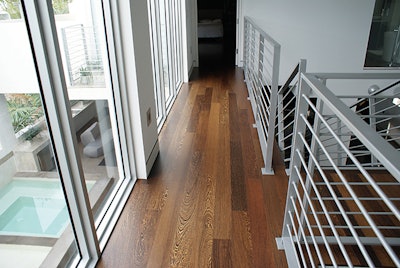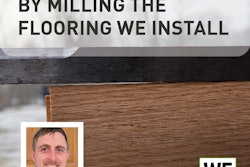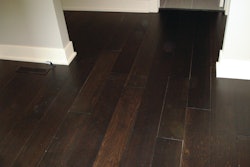
The Problem
I was commissioned to inspect a wenge floor in Southeastern Florida. The wenge flooring had no direct line of sight from the windows, yet the floor was faded. The farther away from the window, the less the floor faded.
The Procedure
The prefinished wenge flooring was installed on the entire upstairs of a contemporary house with an open-floor concept and windows from floor to ceiling. The east and west sections of the home were connected in the middle by a staircase. The stair treads were wenge, as well, but the wood was from another manufacturer. The first tread faded the same as the floor. The farther they were from the windows, the darker the treads were.
The Cause
My first thought when I received the call was that direct sunlight faded the floor. My inspection was at 9:30 a.m. in early January. The homeowner indicated to me that he was a snowbird and was only down from November to February. Upon arriving the homeowner explained that the flooring was fading even though there was no direct sunlight; therefore, he felt that the issue was with the manufacturer's product. I waited until 3:30 p.m. to see if there was any direct sunlight, but, sure enough, there was none.
He felt that the issue was with the manufacturer's product.
Upon returning to my office, I proceeded to analyze solar declination charts and the survey of his home. After overlaying the two, I confirmed there was no direct sunlight in the winter months; however there was direct sunlight in the summer months. This was the supporting documentation I needed.
How to Fix the Floor
Unfortunately, the faded wood flooring must be removed and replaced. A site sand-and-finish would not work, because once the flooring has faded to such an extreme degree, the color difference penetrates into the wood and is not merely on the surface.
In the Future
When choosing a wood floor, several factors should be considered. Especially when using a species known to be highly photosensitive, it's a good idea to evaluate the home using Solar Declination Charts and NOAA Solar Calculators. In the summer, the sun rises considerably north of due east and sets considerably north of due west. In the winter months, it rises considerably south of due east and sets considerably south of due west. The sun's rays hit at significantly different angles depending on season. Take into consideration where direct sunlight will make contact with the wood floor at different times of the year.
A good flooring contractor or sales consultant educates the client on what to expect with photosensitive woods in direct sunlight. Other examples of particularly photosensitive species are Brazilian cherry and American walnut (Brazilian cherry is an example of a wood that darkens with light exposure, even without direct sunlight). As a rule of thumb, many species of wood flooring that are not native to the U.S. are more photosensitive. Some woods get significantly darker with light exposure, and others, like wenge, get lighter. A recommendation may be made that a floor with less photosensitivity be used. If a photosensitive floor is desired, then using window treatments during the hours of direct sunlight to minimize the effects of the sun would be wise. Also, there are window tints that may be used to help reduce the effect, as well.






































